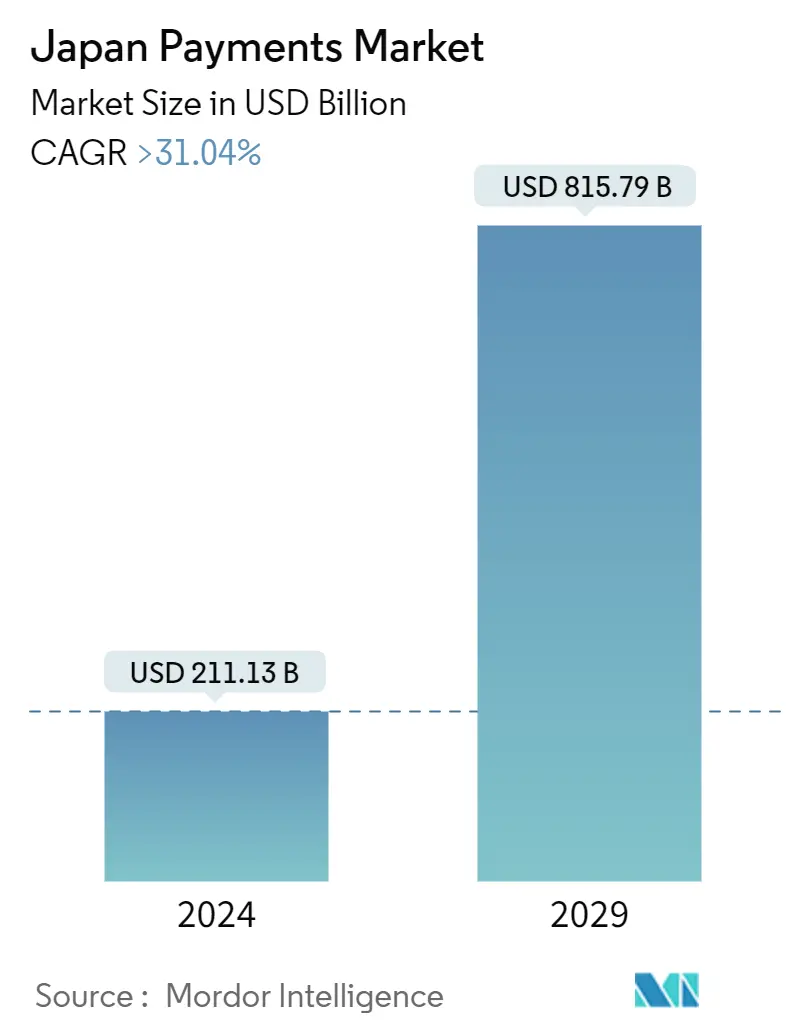Market Size of Japan Payments Industry

| Study Period | 2019 - 2029 |
| Base Year For Estimation | 2023 |
| Market Size (2024) | USD 211.13 Billion |
| Market Size (2029) | USD 815.79 Billion |
| CAGR (2024 - 2029) | 31.04 % |
| Market Concentration | Low |
Major Players
*Disclaimer: Major Players sorted in no particular order |
Japan Payments Market Analysis
The Japan Payments Market size is estimated at USD 211.13 billion in 2024, and is expected to reach USD 815.79 billion by 2029, growing at a CAGR of greater than 31.04% during the forecast period (2024-2029).
Over time, payments have evolved from bartering to token systems (exchanging coins and paper money), currency pooling (deposits and bank accounts), and ultimately cashless transactions. Over the past decade, a significant acceleration in modern payment systems has been witnessed in Japan, among the primary factors influencing the growth of the studied market in Japan.
- Although one of the leading payment methods in the nation is cash, digital transactions are developing quickly, transforming the country into a digital one. Establishing the necessary infrastructure by the Japanese government also aids in ensuring the efficient operation of the payments market.
- The third generation of online technology, Web 3.0, combines structured data and cognitive services to enable the web to understand and accomplish user objectives. Payments may use Web 3.0 to offer users more intelligent and individualized payment experiences. By using natural language processing (NLP) and voice commands, consumers can tell their devices what and how much they wish to pay using Web 3.0 technologies, for instance. Based on a user's past payment history and preferences, Web 3.0 technology can also offer customized payment recommendations and offers. Such technologies are also anticipated to evolve and influence the Japanese payments market during the forecast period.
- Due to their simplicity in enabling online bill payments and other money transfer services, mobile wallets are becoming extremely popular for e-commerce businesses all over Japan. Additionally, the usage of these modern instruments enables quick and secure transactions. These advantages of utilizing a mobile wallet have led to increased use of these products. This factor is anticipated to generate lucrative opportunities in the studied market during the forecast period. Customers of mobile wallets can transfer and receive money with ease due to the user-friendly UI. Users of smartphones can finish their transactions even while on the go due to the user-friendly UI.
- On the flip side, card fraud occurs when thieves use card holder's financial or credit card information to gain unauthorized entry to user accounts and take money. The substantial increase in the number of users who have fallen victim to fraud is caused by the fact that most people's everyday and professional lives are currently virtual or online, as well as the growing complexity of hackers and organized crime groups that target Japan online. Such factors are likely to restrain the growth of the studied market.
- COVID-19 notably impacted the Japanese payments market, with companies like Japan Post Bank intensifying their rivalry with PayPal. The market players are striving towards continued digitalization and innovation in the payments industry to mitigate the effects of the pandemic. Hence, the post-pandemic period is anticipated to witness a continued evolution of the payments industry in Japan.
Japan Payments Industry Segmentation
The payments market is segmented by two modes of payment - POS and e-commerce. E-commerce payments include online purchases of goods and services, such as purchases made on e-commerce websites and online bookings for travel and accommodation. However, they do not include online purchases of motor vehicles, real estate, payments of utility bills (such as water, heating, and electricity), mortgage payments, loans, credit card bills, or purchases of shares and bonds. In the POS segment, all transactions that occur at the physical point of sale are included in the scope of the market studied. It includes traditional in-store transactions and all face-to-face transactions, regardless of where they occur. Cash is also considered for both cases (cash on delivery for e-commerce sales).
The Japanese payments market is segmented by mode of payment (point of sale (card payments, digital wallet, cash), online sale (card payments, digital wallet)), and by end-user industries (retail, entertainment, healthcare, hospitality). The market sizes and forecasts are provided in terms of value (USD) for all the above segments.
| By Mode of Payment | ||||||
| ||||||
|
| By End-user Industry | |
| Retail | |
| Entertainment | |
| Healthcare | |
| Hospitality | |
| Other End-user Industries |
Japan Payments Market Size Summary
The Japan Payments Market is experiencing a transformative shift towards digitalization, driven by advancements in payment technologies and changing consumer preferences. Over the forecast period, the market is expected to witness substantial growth, fueled by the increasing adoption of cashless transactions and the development of robust digital infrastructure by the Japanese government. The integration of Web 3.0 technologies is set to enhance user experiences by offering personalized and intelligent payment solutions. Mobile wallets are gaining popularity due to their convenience and security, facilitating quick and seamless transactions for e-commerce businesses. However, challenges such as card fraud and cyber threats pose potential risks to market expansion.
The retail payments landscape in Japan is characterized by the rise of innovative payment methods and platforms, including buy now, pay later (BNPL) services and QR code payments, which are gaining traction across various sectors. The e-commerce boom, led by major players like Rakuten, Yahoo Japan, and Amazon, is driving the demand for real-time payment solutions and alternative digital currencies. The market is highly fragmented, with key players like Mer Pay Co. Ltd, Mitsubishi UFJ Financial Group, and Japan Post Bank Co. Ltd actively pursuing partnerships and technological advancements to enhance their offerings. Collaborations with global tech firms, such as AWS and Oracle, are enabling Japanese companies to leverage cloud technologies and artificial intelligence, further propelling the digital transformation of the payments industry.
Japan Payments Market Size - Table of Contents
-
1. MARKET INSIGHTS
-
1.1 Market Overview
-
1.2 Industry Stakeholder Analysis
-
1.3 Industry Attractiveness-Porter's Five Forces Analysis
-
1.3.1 Bargaining Power of Suppliers
-
1.3.2 Bargaining Power of Buyers
-
1.3.3 Threat of New Entrants
-
1.3.4 Threat of Substitute Products
-
1.3.5 Intensity of Competitive Rivalry
-
-
1.4 Evolution of the payments landscape in the country
-
1.5 Key market trends pertaining to the growth of cashless transactions in the country
-
1.6 Impact of COVID-19 on the payments market in the country
-
-
2. MARKET SEGMENTATION
-
2.1 By Mode of Payment
-
2.1.1 Point of Sale
-
2.1.1.1 Card Payments (includes Debit Cards, Credit Cards, Bank Financing Prepaid Cards)
-
2.1.1.2 Digital Wallet (includes Mobile Wallets)
-
2.1.1.3 Cash
-
2.1.1.4 Other Modes of Payment
-
-
2.1.2 Online Sale
-
2.1.2.1 Card Payments (includes Debit Cards, Credit Cards, Bank Financing Prepaid Cards)
-
2.1.2.2 Digital Wallet (includes Mobile Wallets)
-
2.1.2.3 Others (includes Cash on Delivery, Bank Transfer, and Buy Now, Pay Later)
-
-
-
2.2 By End-user Industry
-
2.2.1 Retail
-
2.2.2 Entertainment
-
2.2.3 Healthcare
-
2.2.4 Hospitality
-
2.2.5 Other End-user Industries
-
-
Japan Payments Market Size FAQs
How big is the Japan Payments Market?
The Japan Payments Market size is expected to reach USD 211.13 billion in 2024 and grow at a CAGR of greater than 31.04% to reach USD 815.79 billion by 2029.
What is the current Japan Payments Market size?
In 2024, the Japan Payments Market size is expected to reach USD 211.13 billion.

